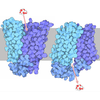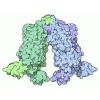+ Open data
Open data
- Basic information
Basic information
| Entry | Database: PDB / ID: 9kmq | ||||||
|---|---|---|---|---|---|---|---|
| Title | CryoEM structure of osPHT1-11 at pH 8.0 | ||||||
 Components Components | Inorganic phosphate transporter 1-11 | ||||||
 Keywords Keywords | TRANSPORT PROTEIN / phosphorus / rice / uptake | ||||||
| Function / homology |  Function and homology information Function and homology informationphosphate transmembrane transporter activity / phosphate ion transport / symporter activity / membrane Similarity search - Function | ||||||
| Biological species |  | ||||||
| Method | ELECTRON MICROSCOPY / single particle reconstruction / cryo EM / Resolution: 3.3 Å | ||||||
 Authors Authors | Du, Z.M. / Guan, Z.Y. / Liu, Z. | ||||||
| Funding support |  China, 1items China, 1items
| ||||||
 Citation Citation |  Journal: Dev Cell / Year: 2025 Journal: Dev Cell / Year: 2025Title: Cryo-EM structure and dynamic basis of phosphate uptake by PHT1 in rice. Authors: Zhangmeng Du / Zeyuan Guan / Hai Liu / Jie Zhang / Haitao He / Zhiwen Zheng / Wenhui Zhang / Lihuan Jiang / Jiaqi Zuo / Yan Liu / Beijing Wan / Haifu Tu / Faming Dong / Xuelei Lai / Lizhong ...Authors: Zhangmeng Du / Zeyuan Guan / Hai Liu / Jie Zhang / Haitao He / Zhiwen Zheng / Wenhui Zhang / Lihuan Jiang / Jiaqi Zuo / Yan Liu / Beijing Wan / Haifu Tu / Faming Dong / Xuelei Lai / Lizhong Xiong / Ping Yin / Shaowu Xue / Yanke Chen / Zhu Liu /  Abstract: Phosphorus is an essential macronutrient for plants, primarily absorbed from the soil as inorganic phosphate (Pi) through root-located Pi transporters. Despite decades of research into these ...Phosphorus is an essential macronutrient for plants, primarily absorbed from the soil as inorganic phosphate (Pi) through root-located Pi transporters. Despite decades of research into these transporters as targets for developing Pi-efficient crops, their mechanisms for Pi import remain poorly understood. Here, we present the cryo-electron microscopy (cryo-EM) structures of the rice Pi importer OsPHT1;11 in both Pi-bound and unbound forms, characterize its conformational dynamics, and demonstrate how these dynamics contribute to its transport function. Pi is recognized through conserved residues found in plants, with its translocation facilitated by a typical alternating-access mechanism. Single-molecule fluorescence resonance energy transfer (smFRET) analyses show that this transporter undergoes dynamic conformational fluctuations, which are differentially linked to its Pi transport capability, with a predominance of extracellular open conformations favoring Pi transport, while more populated intracellular open conformations hinder it. These findings highlight key conformational determinants of transport activity and provide mechanistic insights into Pi uptake in plants. | ||||||
| History |
|
- Structure visualization
Structure visualization
| Structure viewer | Molecule:  Molmil Molmil Jmol/JSmol Jmol/JSmol |
|---|
- Downloads & links
Downloads & links
- Download
Download
| PDBx/mmCIF format |  9kmq.cif.gz 9kmq.cif.gz | 176.9 KB | Display |  PDBx/mmCIF format PDBx/mmCIF format |
|---|---|---|---|---|
| PDB format |  pdb9kmq.ent.gz pdb9kmq.ent.gz | 138.3 KB | Display |  PDB format PDB format |
| PDBx/mmJSON format |  9kmq.json.gz 9kmq.json.gz | Tree view |  PDBx/mmJSON format PDBx/mmJSON format | |
| Others |  Other downloads Other downloads |
-Validation report
| Arichive directory |  https://data.pdbj.org/pub/pdb/validation_reports/km/9kmq https://data.pdbj.org/pub/pdb/validation_reports/km/9kmq ftp://data.pdbj.org/pub/pdb/validation_reports/km/9kmq ftp://data.pdbj.org/pub/pdb/validation_reports/km/9kmq | HTTPS FTP |
|---|
-Related structure data
| Related structure data |  62441MC  9kouC M: map data used to model this data C: citing same article ( |
|---|---|
| Similar structure data | Similarity search - Function & homology  F&H Search F&H Search |
- Links
Links
- Assembly
Assembly
| Deposited unit | 
|
|---|---|
| 1 |
|
- Components
Components
| #1: Protein | Mass: 63575.168 Da / Num. of mol.: 2 Source method: isolated from a genetically manipulated source Source: (gene. exp.)  Gene: PHT1-11, PT11, Os01g0657100, LOC_Os01g46860, OsJ_002785, P0694A04.21 Cell line (production host): HEK293 / Production host:  Homo sapiens (human) / References: UniProt: Q94DB8 Homo sapiens (human) / References: UniProt: Q94DB8Has protein modification | N | |
|---|
-Experimental details
-Experiment
| Experiment | Method: ELECTRON MICROSCOPY |
|---|---|
| EM experiment | Aggregation state: PARTICLE / 3D reconstruction method: single particle reconstruction |
- Sample preparation
Sample preparation
| Component | Name: osPHT1-11 / Type: COMPLEX / Entity ID: all / Source: RECOMBINANT |
|---|---|
| Source (natural) | Organism:  |
| Source (recombinant) | Organism:  Homo sapiens (human) Homo sapiens (human) |
| Buffer solution | pH: 8 |
| Specimen | Embedding applied: NO / Shadowing applied: NO / Staining applied: NO / Vitrification applied: YES |
| Vitrification | Cryogen name: ETHANE |
- Electron microscopy imaging
Electron microscopy imaging
| Experimental equipment |  Model: Titan Krios / Image courtesy: FEI Company |
|---|---|
| Microscopy | Model: TFS KRIOS |
| Electron gun | Electron source:  FIELD EMISSION GUN / Accelerating voltage: 300 kV / Illumination mode: FLOOD BEAM FIELD EMISSION GUN / Accelerating voltage: 300 kV / Illumination mode: FLOOD BEAM |
| Electron lens | Mode: BRIGHT FIELD / Nominal defocus max: 2000 nm / Nominal defocus min: 1200 nm |
| Image recording | Electron dose: 50 e/Å2 / Film or detector model: GATAN K3 BIOQUANTUM (6k x 4k) |
- Processing
Processing
| EM software | Name: PHENIX / Category: model refinement | ||||||||||||||||||||||||
|---|---|---|---|---|---|---|---|---|---|---|---|---|---|---|---|---|---|---|---|---|---|---|---|---|---|
| CTF correction | Type: NONE | ||||||||||||||||||||||||
| Symmetry | Point symmetry: C1 (asymmetric) | ||||||||||||||||||||||||
| 3D reconstruction | Resolution: 3.3 Å / Resolution method: FSC 0.143 CUT-OFF / Num. of particles: 346493 / Symmetry type: POINT | ||||||||||||||||||||||||
| Refine LS restraints |
|
 Movie
Movie Controller
Controller




 PDBj
PDBj


